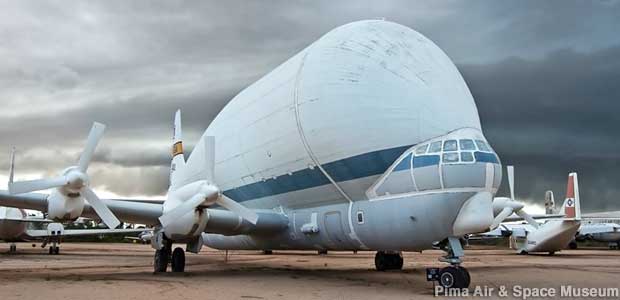
Bulbous "Super Guppy" was built to fly giant moon rocket parts to their launch pads in Florida.
Pima Air & Space Museum
Tucson, Arizona
Noble goals of preservation and patriotism contributed to the creation of the Pima Air & Space Museum. But the main reason was that the famous Aircraft Boneyard across the street didn't want any more of its historic planes sent to the smelter.
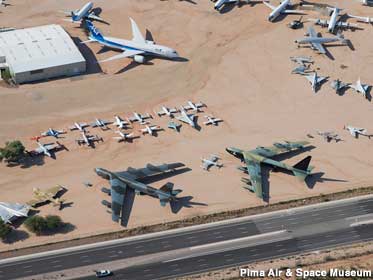
From the air you can quickly spot the museum's 787 Dreamliner, and two of its B-52s.
According to museum executive director Scott Marchand, the Boneyard -- run by the military -- would park its most interesting aircraft along the roadside so passers-by could see them through the fence. "It got to be so many aircraft," said Scott, "that by 1963 the Pentagon said, 'Okay, gentlemen, you've had your fun, now get back to business. Get rid of these things.'"
The Boneyard did, but not in the way the Pentagon intended. A deal was struck with Tucson's community leaders to develop a public museum, just across the road from the Boneyard, which would preserve its historic aircraft.
The Pima Air Museum (its original name) was at first just a fenced-in patch of desert with a couple dozen old bombers and jet fighters. Today it houses America's third largest collection of things that fly, everything from weird prototypes to commercial airliners to spacecraft. "The big misperception is that we're just a military junkyard," said Scott, who added that the museum is not owned or run by the government or the military. "We are the spawn of the Boneyard, but we're not the Boneyard Museum. It's an understandable confusion."
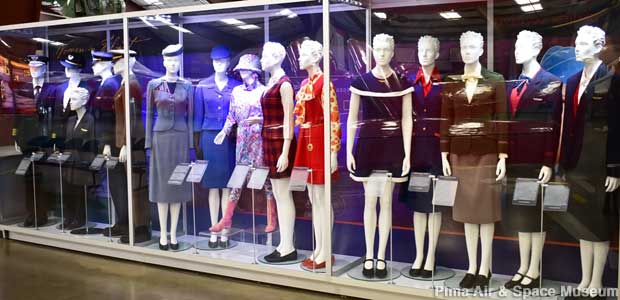
"Women in Flight" exhibit includes stewardess uniforms from 1930 to 2000. Skirt height peaked in 1971.
Although the museum has six indoor hangers packed with aircraft and exhibits, it's best known for its 80 acres of outdoor displays, made possible by the same desert conditions that first attracted the Boneyard: there's hardly any rain, and the soil is as hard as concrete. Scott said that "the desert Southwest in summer is no deterrent" to tourists, but the museum nevertheless provides an optional, shaded, guided tram tour for its less-vigorous outdoor visitors. Water bottles and hats are recommended for everyone. Rattlesnakes and scorpions are here, too, said Scott, but they usually only come out at night.
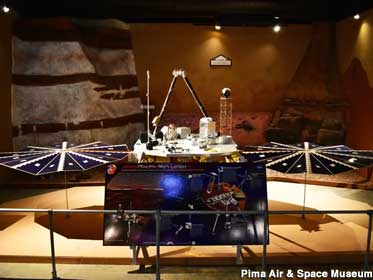
Phoenix Mars Lander came to the museum from NASA's University of Arizona lab.
Some of the museum's outdoor aircraft look as if they were dragged out of the Boneyard yesterday, but many others are in fine shape. There are jet fighters, refuelers, commercial aircraft, NASA spacecraft, helicopters, cargo planes, racing planes, home-built planes. The world's first 777 is here, as is the last flying 1960s 747, and the world's oldest B-52 (it dropped the X-15 piloted by many early NASA astronauts). The bulbous Super Guppy, which somehow flew sections of the giant Saturn V moon rocket to Florida, is a visitor favorite. Only a few steps from a Space Shuttle solid rocket booster is the last propellor-driven Air Force One, rejected by JFK because it jiggled his bad back, but beloved by LBJ, who had a set of flight instruments installed in his cabin. "He would monitor the pilots," said Scott. "If he didn't like the altitude or airspeed he would call up the cockpit and say so."
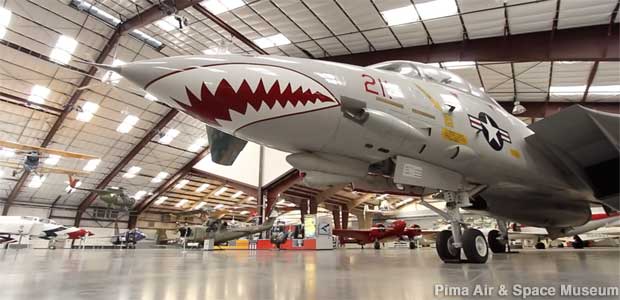
Pima's hangers shelter dozens of planes, including a Grumman F-14A Tomcat from the movie "Top Gun."
Several of the outdoor aircraft -- derelicts with no historical value -- have been turned into artworks by well-known graffiti artists, sporting colorful designs ranging from from cartoony faces to human skulls. "We've had people grumble that it's disrespecting veterans," said Scott. "An Air Force colonel told me, 'I don't personally get it, but my kids really like it.'"
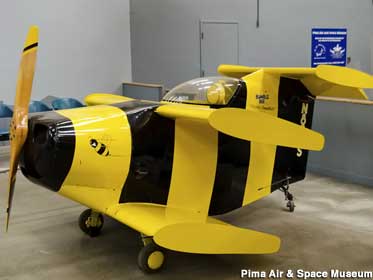
The Bumble Bee was once the world's smallest airplane, held only two gallons of gas.
The museum showcases its older and more fragile aircraft indoors, along with thousands of related artifacts. You might spot a wedding dress made from World War II parachutes, or a red SS Death's Head fez made by enslaved labor at Dachau. The "Woman in Flight" exhibit includes a chorus line of historic stewardess uniforms; a 1968 ensemble features pink go-go boots. The Space Gallery displays Apollo and Mercury training capsules and a moon rock donated by Apollo astronaut (and Tucson resident) Frank Borman. Some surprisingly giant aircraft are parked on the hangar floors, but our attention was drawn to the pipsqueak Bumble Bee, which held only two gallons of gas and was briefly the world's smallest airplane; and the U.S. Army Hoppi-Copter, a backpack helicopter that had the unfortunate habit of breaking the legs of GIs who tried to land it, and wooden blades that splintered into deadly shards if they hit the ground. "It's a terrific example of what happens when engineers are given too much freedom to develop an idea," said Scott.
Despite the Pima Air & Space Museum's years of expansions and improvements, its initial thrill has endured: the freedom for tourists to walk around outside, in the desert, and look at and touch old airplanes, as if they'd wandered into a post-Apocalyptic movie or time warp. "It can get pretty challenging late in the afternoon when it's 115 degrees outside," said Scott. "But part of the experience is being able to go back home and say, 'Ohmigod, you wouldn't believe how hot it was.'"






